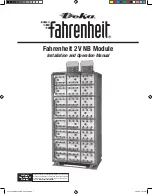
IN REFERENCE TO
THIS MANUAL:
– “Cell” is defined as an individual 2-volt unit
– “Battery string” is defined as a series connected electrical
system comprised of cells (individual 2-volt units).
SAFETY PRECAUTIONS
Although all valve-regulated cells have the electrolyte immobi-
lized within the cell, the electrical hazard associated with
batteries still exists.
Work performed on these batteries
should be done with the tools and the protective equipment
listed below.
Valve-regulated cell installations should be
supervised by personnel familiar with batteries and battery
safety precautions.
WARNING:
Risk of fire, explosion or burns. Do not
disassemble, heat above 65°C, or incinerate.
Protective Equipment
Although VRLA cells can vent or leak small amounts of
electrolyte, electrical safety is the principle but not the only
concern for safe handling. Per IEEE 1188 recommendations, the
following minimum set of equipment for safe handling of the
cells and protection of personnel shall be available:
1.
Safety glasses with side shields, or goggles, or face
shields as appropriate. (Consult application specific
requirements)
2. Electrically insulated gloves, appropriate for the installation.
3. Protective aprons and safety shoes.
4. Portable or stationary water facilities in the battery
vicinity for rinsing eyes and skin in case of contact
with acid electrolyte.
5. Class C fire extinguisher.
6. Acid neutralizing agent.
7. Adequately insulated tools.
8. Lifting devices of adequate capacity, when required.
Procedures
The following safety procedures should be followed during
installation:
(Always wear safety glasses or face shield
when working on or near batteries.)
1. These cells are sealed and contain no free electrolyte. Under
normal operating conditions, they do not present any acid
danger. However, if the cell jar or cover is damaged, acid
could be present.
Sulfuric acid is harmful to the skin and
eyes. Flush affected area with water immediately and
consult a physician if splashed in the eyes.
Consult SDS
for additional precautions and first aid measures.
2.
Prohibit smoking and open flames, and avoid arcing in
the immediate vicinity of the battery.
3. Do not wear metallic objects, such as jewelry, while working
on cells. Do not store un-insulated tools in pockets or tool
belt while working in vicinity of battery.
4. Keep the top of the battery dry and clear of tools and other
foreign objects.
5. Provide adequate ventilation
(per IEEE standard 1187 and/
or local codes)
and follow recommended charging voltages.
6. Extinguishing media: Class ABC extinguisher.
Note: CO
2
may be used but not directly on the cells due
to thermal shock and potential cracking of cases.
7.
Never
remove or tamper with the pressure relief valves
unless for cell replacement. Warranty void if vent valve is
removed.
8. Inspect all flooring and lifting equipment
for functional adequacy.
9. Adequately secure battery modules, racks, or cabinets to
the floor.
10. Connect support structures to ground system
in accordance with applicable codes.
11. The below IEEE Standards contain additional information.
Other standards may be relevant to your specific application.
IEEE 1187 – Recommended Practice for Installation
Design of VRLA Batteries
IEEE 1188 – Recommended Practice for Maintenance,
Testing, of VRLA Batteries
IEEE 1189 – Selection of VRLA Batteries for Stationary
Applications
RECEIVING & STORAGE
Receiving Inspection
Upon receipt, and at the time of actual unloading, each
package should be visually inspected for any possible damage
or electrolyte leakage. If either is evident, a more detailed
inspection of the entire shipment should be conducted and
noted on the bill of lading. Record receipt date, inspection date
and notify carrier of any damage.
Unpacking
1.
Always wear eye protection.
2. Check all cells for visible defects such as cracked
containers, loose terminal posts, or other unrepairable
problems. Cells with these defects must be replaced.
3. Check the contents of the packages against the packaging
list. Report any missing parts or shipping damage to your
East Penn agent or East Penn Mfg. Co. immediately.
4. Never lift batteries by the terminal posts.
5. When lifting cells, the proper equipment is needed such
as a forklift or a portable crane. Always check the lifting
capacities of the equipment being used and never
lift more than one module and/or cell at a time.
System Shipment
Battery System will be received with cells and modules on
separate pallets. Amount of pallets dependent on number of cells
and module type.
3
2600_Fahrenheit-2V-NB-mod_I&O.indd 3
2600_Fahrenheit-2V-NB-mod_I&O.indd 3
2/22/22 2:44 PM
2/22/22 2:44 PM


















